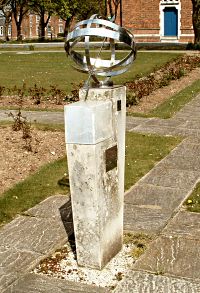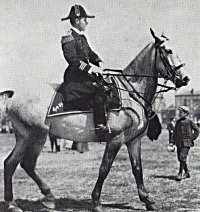Location
In the Rose Garden to the South West of the Museum Block at HMS Excellent.

Commander Chatfield

THIS MEMORIAL STANDS IN THE ROSE
GARDEN ORIGINALLY LAID OUT BY
LORD CHATFIELD WHEN COMMANDER
OF H.M.S. EXCELLENT PRESENTED
BY THE CHATFIELD FAMILY AND
MADE IN THE WORKSHOPS OF
HMS EXCELLENT 1968
Inscription (West Side)
IN MEMORY OF
ADMIRAL OF THE FLEET
THE BARON CHATFIELD
PC GCB OM KCMG CVO DCL LLD DL
1873 - 1967
LONG GUNNERY COURSE 1897
COMMANDER HMS EXCELLENT 1906 - 1909
FIRST SEA LORD 1933 - 1938
MINISTER FOR CO-ORDINATION OF DEFENCE 1939 - 1940
Further Information
Alfred Ernle Montacute Chatfield was born on 27 September 1873 in Southsea, the fourth child of Admiral Alfred John Chatfield (1831–1910) and his wife, Louisa, eldest daughter of Thomas Faulconer, of Hampstead. He was educated at St Andrew's School, Tenby, and in 1886 passed the examination for entry into the Britannia, joining her at Dartmouth a few days before his thirteenth birthday.
As a lieutenant Chatfield specialized in gunnery, taking a Long Gunnery Course at Excellent in 1897, and in 1899 took up his first sea-going appointment as a gunnery specialist in HMS Caesar. In 1909 Chatfield married Lillian Emma St John (d. 1977), daughter of Major George L. Matthews; they had two daughters, one of whom died in 1943, and one son.
In March 1906 he returned to Excellent as Commander where he remained until 1909 when he was promoted captain and appointed to command the Albemarle in the Atlantic Fleet, in which one of his fellow captains was David Beatty. He first became Beatty's flag captain in the Aboukir for six weeks during the manoeuvres of 1912, and when Beatty was appointed in 1913 to command the battle-cruiser squadron, flying his flag in the Lion, he again took Chatfield with him as his flag captain with the additional responsibility of organizing and training the squadron in gunnery. Thus he took part in the three principal actions fought in the North Sea, those of Heligoland Bight (28 August 1914), Dogger Bank (24 January 1915), and Jutland (31 May 1916). The Lion was heavily hit at both the Dogger Bank and the Jutland battles, sustaining considerable damage, due in part to the faulty distribution of fire of the battle cruisers which in each action left a German opponent unengaged, a surprising lapse in a gunnery officer of Chatfield's calibre. Chatfield remained in the Lion until November 1916, when Beatty relieved Sir John Jellicoe as commander-in-chief, Grand Fleet, and again Chatfield went with him as flag captain and chief of staff first in the Iron Duke and later in the Queen Elizabeth.
In June 1919, Chatfield went to the Admiralty as fourth sea lord, becoming assistant chief of staff in February 1920. He was promoted rear-admiral in August 1920 and in 1921 took over from Beatty as the senior naval delegate in Washington. After two years in command of the 3rd cruiser squadron in the Mediterranean, Chatfield returned to the Admiralty in 1925 as third sea lord and controller of the navy. He was promoted vice-admiral in 1926.
On leaving the Admiralty, Chatfield hoisted his flag in 1929 in the Nelson as commander-in-chief, Atlantic Fleet, and a year later was transferred to the Mediterranean Fleet, having in the meantime been promoted admiral (1930). He flew his flag in the Queen Elizabeth, the same ship in which he had ended the First World War as Beatty's flag captain. In 1933, on the expiration of his term of command, Chatfield realized his great ambition by returning to the Admiralty as first sea lord. His term of office was twice extended, and he left the Admiralty in August 1938, having been promoted admiral of the fleet in 1935 and raised to the peerage as first Baron Chatfield in the coronation honours list of 1937.
Chatfield died at his home, the Small House, Farnham Common, on 15 November 1967
[Adapted from the entry in the Dictionary of National Biography by Peter Kemp]
Lord Chatfield was responsible for laying out the Rose Garden, in which his memorial now stands, in 1906 during his period as Commander of HMS Excellent.
